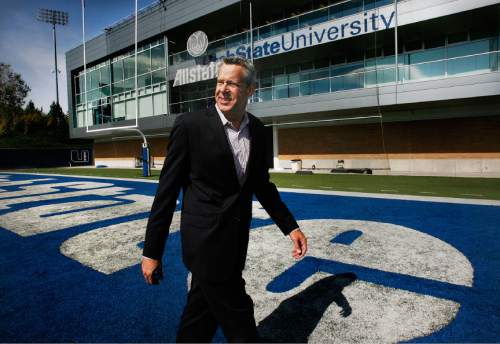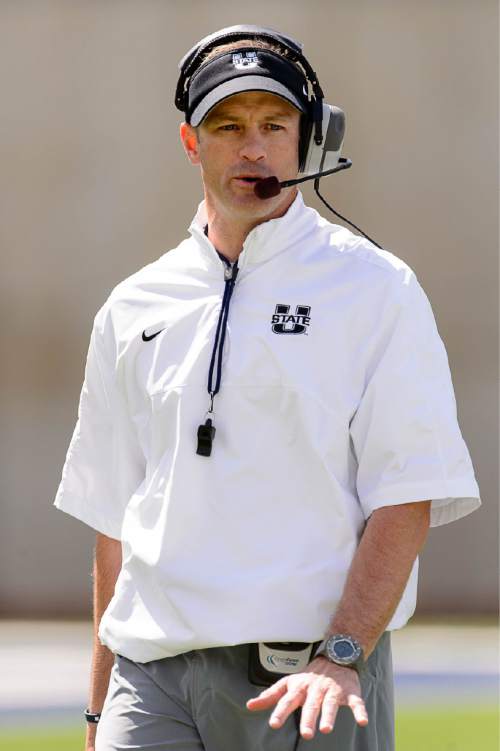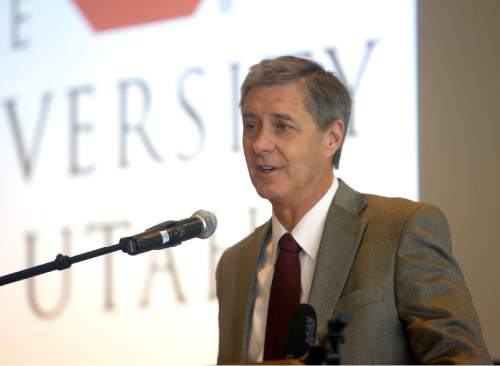This is an archived article that was published on sltrib.com in 2015, and information in the article may be outdated. It is provided only for personal research purposes and may not be reprinted.
In the past few years, Utah State University has completed the $6.5 million ICON Sports Performance Center, the $9.7 million Wayne Estes basketball practice facility, landed a $2.4 million Nike apparel contract and announced a 21-year agreement with Maverik that will provide much of the funding for upcoming football-stadium renovations.
To say the Aggies are in a growth spurt would be putting it mildly.
One might then wonder why, when it has forked out millions of dollars for various athletic projects, the school would feel the need to go to the Utah Legislature and ask for more money for USU sports?
Last month, state lawmakers approved $1.5 million in funding for USU athletics at the request of Senate Budget Chairman Lyle Hillyard, R-Logan.
The Legislature routinely doles out funding to various groups seeking public dollars to help subsidize operations. But this is the first time in memory that taxpayer money has been tapped to fund a state university's athletic program — which already generates money from football and men's basketball, student fees and private donations.
Hillyard argued, however, that USU needed the funds to remain competitive after recent NCAA rule changes that will allow schools in the "Power 5 conferences" — the ACC, Big Ten, Big 12, Pac-12 and SEC — and Notre Dame to pay the full cost of athletic scholarships, covering items such as rent, meals and clothing. The change has left the nonpower leagues, such as the Aggies' Mountain West Conference, scrambling to keep up.
Hillyard's request was approved as a "Utah Wellness Program" expenditure that would help boost the area's economy.
That taxpayer money is going to the Aggies may rankle Utahns who align themselves with other schools in the state — or don't follow college sports at all. But if one thinks outgoing USU athletic director Scott Barnes is concerned about such grumbling, think again.
He insists the Aggies need the funds.
"We don't have $21 million TV contracts or affiliations with big conferences like Utah does with the Pac-12," Barnes said. "We looked at every measure we could and analyzed and strategized how we can get this done, and it's not possible for us to do it by raising funds at our level."
Barnes said the legislative earmark will be used solely to support USU student-athletes. The school is still analyzing how much it will cost, but estimates are it will be $3,700 per student-athlete.
Around $800,000 will go toward scholarships, while the remaining $700,00 will be directed toward stipends for items such as housing, meals and other expenses student-athletes incur.
Barnes said the lawmaker-provided boost won't cover all the expenses the school must pay for, but it will go a long way in helping USU provide more money for what it really costs for an Aggie athlete to attend school in Logan.
"All of this is going directly to the student-athletes," he said. "We are going to have to figure out how to make up for the rest, but this is going to help us get a ways down the road."
Of course, Barnes soon will be leaving the have-nots for the haves, since he has been hired as Pitt's new athletic director beginning July 1.
As part of the ACC, Pitt gets a hefty share of the league's 15-year $3.6 billion TV contract with ESPN. In 2013-14, each school received $20.8 million from the league.
For that same year, the total revenue for the entire Mountain West Conference was $29 million. Boise State received the most money, thanks to additional TV bonuses. But its payout still was only $3.7 million, a far cry from the money available to the ACC and other power conferences.
Perhaps mindful of its own economical windfall as a member of the Pac-12, Utah hasn't made a push for money from the Legislature. Athletic director Chris Hill plans to raise the $1 million he needs for cost of attendance from boosters and other sources.
"We have our own system and priorities and opportunities," Hill said. "Going to the Legislature just wasn't going to be a priority for us."
Before joining the Pac-12, Hill frequently said athletic directors had to get creative to find necessary funding. One certainly can make the argument that the Aggies did just that in seeking money from lawmakers.
The idea to go to the Legislature was crafted during a meeting with donors. Aggies' booster Jim Laub initiated the proposal of going to Hillyard for legislative help. He had the blessing of Barnes, who said raising money continues to be the No. 1 task for the school's athletic department.
"Every dollar we get is spent now trying to keep up, and money isn't a renewable resource like water," Barnes said. "You need it every year, but you have to raise it."
Nevertheless, the move has raised some eyebrows among collegiate sports watchdogs.
David Berri, a professor of economics at Southern Utah University who focuses on sports economics and the changing financial college landscape, said the Legislature's willingness to give the school money for athletics shows just how skewed priorities are.
"It's out of whack," he said. "Universities should be for educating people. The revenue generated from sports is plowed back into athletics, so I'm not clear what it is doing for us as residents."
Barnes said he realized how important the cost-of-scholarship topic is to recruits when he met with a tennis player who was on a recruiting visit last spring.
"He wanted to know what we were doing about it," he said. "This is on the forefront of recruits' minds and concerns. Getting this [funding] helps change the trajectory of who we are and where we want to go."
USU football coach Matt Wells said he, too, is frequently asked about the school's ability to pay for costs beyond tuition that current scholarships cover. Athletes, it seems, want to know more than just the new uniform style Nike will have for them.
"We need it to stay in the game," Wells said. "It's going to help us keep relevant in a lot of areas, and we need to be able to provide student-athletes a first-class experience."
Berri, meanwhile, wonders just how many legislators consider themselves fans of USU athletics and how big a role that might have played into their decision.
"I have seats available for my lectures," he joked. "They can cheer, and they only last 50 minutes."







